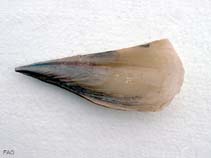Atrina pectinata (Linnaeus, 1767)
Comb pen shell| Native range | All suitable habitat | Point map | Year 2050 |

|
| This map was computer-generated and has not yet been reviewed. |
| Atrina pectinata AquaMaps Data sources: GBIF OBIS |
Classification / Names Common names | Synonyms | CoL | ITIS | WoRMS
Bivalvia | Ostreida | Pinnidae
Environment: milieu / climate zone / depth range / distribution range Ecology
Benthic; depth range 0 - 200 m (Ref. 2754). Subtropical; 1°C - 39°C; 63°N - 41°S, 17°W - 137°W
Distribution Countries | FAO areas | Ecosystems | Occurrences | Introductions
Mediterranean and Indo-West Pacific: from southeast Africa to Melanesia and New Zealand; north to Japan and south to New South Wales. Tropical to subtropical.
Length at first maturity / Size / Weight / Age
Maturity: Lm 15.8, range 10 - ? cm Max length : 39.0 cm SHH male/unsexed; (Ref. 124193); common length : 26.0 cm SHL male/unsexed; (Ref. 348)
Short description Morphology
Shell reaching a large size, usually rather thin, fragile, moderately inflated and triangularly wedge-shaped in outline, with a highly variable sculpture. Dorsal margin nearly straight or slightly concave, posterior margin generally truncate. Ventral margin widely convex posteriorly, straightish to shallowly depressed anteriorly. Outer surface of valves with 15 to 30 radial ribs which may be smooth to densely set with short, open spines. Dorsal most radial rib frequently with a series of short and sharp spines protruding along the dorsal margin of shell. Inner surface of shell with shallow grooves corresponding to the external radial ribs. Internal nacreous layer rather thin, undivided, occupying the anterior 2/3 to 3/4 of valves. Posterior adductor scar completely enclosed within the nacreous area. Colour: outside of shell slightly shiny, translucent olivaceous tan, often tinged with darker purplish brown or grey toward the umbones. Interior similarly coloured, iridescent on nacreous area.
New Zealand populations are generally considered a distinct subspecies under the name Atrina pectinata zelandica (Gray, 1835). It is collected in many areas for food and fertilizer (Ref. 348). Minimum depth from Ref. 348.
Life cycle and mating behavior Maturity | Reproduction | Spawning | Eggs | Fecundity | Larvae
Members of the class Bivalvia are mostly gonochoric, some are protandric hermaphrodites. Life cycle: Embryos develop into free-swimming trocophore larvae, succeeded by the bivalve veliger, resembling a miniature clam.
Main reference
References | Coordinator | Collaborators
Poutiers, J.M. 1998. (Ref. 348)
IUCN Red List Status (Ref. 130435: Version 2024-1)
CITES status (Ref. 108899)
Not Evaluated
CMS (Ref. 116361)
Not Evaluated
Threat to humans
Human uses
Fisheries: commercial
| FishSource |
Tools
More information
Trophic Ecology
Ecology
Population dynamics
Life cycle
Distribution
Human Related
Aquaculture profile
Stamps, Coins Misc.
Stamps, Coins Misc.
Outreach
References
Internet sources
BHL | BOLD Systems | CISTI | DiscoverLife | FAO(Publication : search) | Fishipedia | GenBank (genome, nucleotide) | GloBI | Gomexsi | Google Books | Google Scholar | Google | PubMed | Tree of Life | Wikipedia (Go, Search) | Zoological Record
Estimates based on models
Preferred temperature
(Ref. 115969): 15.9 - 28.5, mean 26.5 (based on 1541 cells).
Resilience
(Ref. 69278):
High, minimum population doubling time less than 15 months (K=0.53-0.78; tm=1).
Price category
(Ref. 80766):
Unknown.



